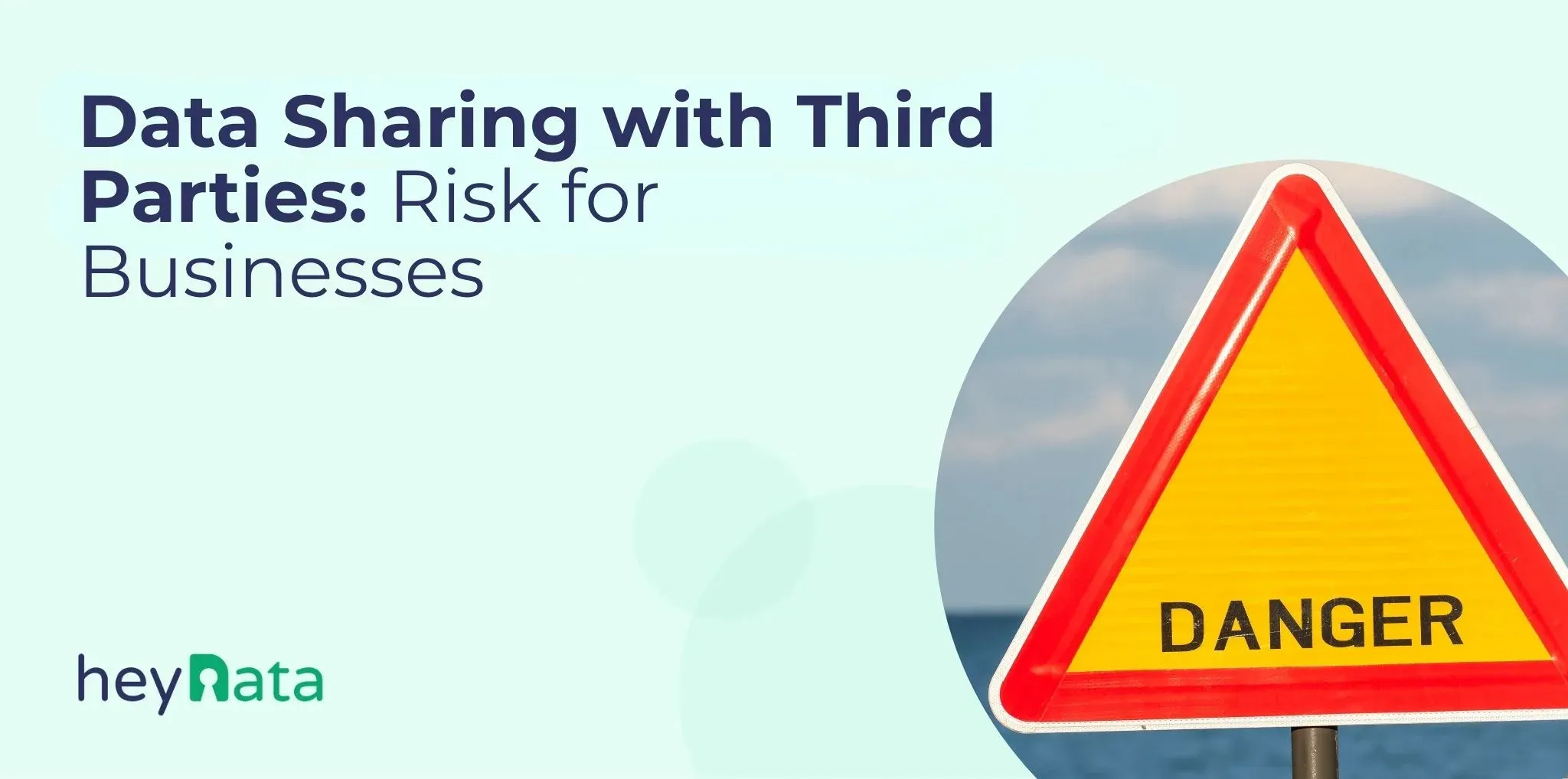
Data Sharing with Third Parties: The Underestimated Risk for Businesses

Introduction: Why This Topic Is More Relevant Than Ever
In today’s digital world, data is often referred to as the new gold. Every day, businesses collect and process vast amounts of data to streamline operations and better serve their customers. But with this abundance of data comes great responsibility. Sharing data with third parties can pose significant risks—many of which are underestimated.
Recent data protection scandals and strict regulations like the GDPR have heightened awareness of the importance of data protection and compliance. Businesses must understand their responsibilities and ensure legal compliance to avoid heavy fines and reputational damage.
Table of Contents:
What Does “Data Sharing with Third Parties” Actually Mean?
Data sharing with third parties refers to the process by which a company transfers personal or sensitive data to external service providers or business partners. This can take many forms—from cloud providers processing customer data to accounting firms managing financial records.
It’s important to understand that such transfers include not only the data itself but also the related processes and security measures. Without proper precautions, data sharing can lead to data breaches and serious legal consequences.
Why Compliance Is Critical When Sharing Data
At its core, compliance means adhering to all applicable legal, regulatory, and contractual obligations. When it comes to sharing personal data with third-party providers, this is particularly important—not only because of potential fines, but also due to the risk of losing the trust of customers, partners, and the public.
Obligation to Ensure GDPR Compliance
According to Article 5(1) of the GDPR, personal data must be processed lawfully, for a specified purpose, transparently, and securely. When working with external service providers, the data controller remains fully responsible for ensuring data protection—even if the processing is outsourced.
Article 28 of the GDPR makes it clear: data processing by a processor is only permitted if:
- a written data processing agreement (DPA) is in place,
- the service provider is selected based on data protection criteria, and
- technical and organizational measures (TOMs) are implemented and documented (Art. 32 GDPR).
Trust as a Competitive Advantage
Compliance isn’t just a legal obligation—it’s a strategic asset. Customers, investors, and partners increasingly value transparent and secure data processes. Those who establish clear policies, conduct regular audits, and document security measures foster trust, a key competitive advantage in the digital age.
Legal Requirements and Their Impact
Legal requirements for data sharing vary by region and industry. In the European Union, the General Data Protection Regulation (GDPR) is the most important framework for processing personal data.
Companies must ensure compliance with GDPR requirements, including obtaining consent from data subjects, implementing adequate security measures, and reporting data breaches within 72 hours. Non-compliance can result in significant fines and reputational harm.
The GDPR obliges companies to:
- obtain explicit consent from data subjects,
- carefully select data processors,
- implement technical and organizational measures (TOMs),
- document processing activities and report violations.
Violations can result in fines of up to €20 million or 4% of global annual turnover, along with considerable damage to brand reputation.
Hidden Risks: Where the Real Dangers Lie
When thinking about data sharing with third parties, many immediately think of obvious risks such as hacking, data leaks, or the loss of sensitive information. But the real threats often lie in the overlooked details of day-to-day operations, creating serious weak points for compliance and data security.
1. Unclear or Missing Contractual Agreements
Many companies share data with service providers without a valid and GDPR-compliant DPA, or they rely on outdated or vague templates.
Example: A mid-sized online retailer hires an external agency to send newsletters. The agency gets full access to the customer database, but there’s no DPA in place specifying how the data may be used, who can process it, or how long it can be stored. In the event of a breach, the retailer—not the agency—is held accountable.
2. Lack of Control Over Subprocessors
Even with a signed contract, many providers use subprocessors—e.g., hosting services, payment providers, or external development teams. This “chain” of data transfers is often not fully transparent.
Example: A German company uses a US-based cloud CRM tool. That provider stores data with a third party in India—without this being disclosed or contractually secured. The company loses control over the data flow and risks violating GDPR, especially regarding international transfers (Art. 44 GDPR and beyond).
3. Insufficient Technical and Organizational Measures (TOMs)
Data security hinges on implemented safeguards. Yet not all third parties uphold high standards—e.g., encryption, access controls, or deletion policies.
Example: An HR software tool stores applicant data on unencrypted servers. Unauthorized internal access goes unnoticed for months. The hiring company didn’t vet the provider’s security measures and is therefore partly responsible.
4. Lack of Oversight and Audits
Many businesses fail to monitor their providers through audits, self-assessments, or certifications (e.g., ISO 27001, SOC 2). Without proper controls, it’s unclear whether promised data protection standards are met.
Example: A company outsources payroll to a provider and trusts verbal assurances of compliance. A later audit reveals unprotected employee data stored locally—a clear violation due to lack of oversight.
Legal Pitfalls: GDPR, DPAs & More
GDPR is clear: companies that share personal data with third parties remain fully responsible and must legally safeguard these partnerships. Yet common mistakes continue to lead to severe penalties.
1. Missing or Incomplete Data Processing Agreements (Art. 28 GDPR)
A frequent error is working without a proper DPA or with vague contract clauses. Article 28(3) GDPR requires that DPAs regulate:
- subject and duration of processing
- type and purpose of processing
- categories of data subjects and data types
- processor’s confidentiality and security obligations
- instructions and audit rights of the controller
Example: A marketing automation SaaS tool is engaged, but the DPA is just a generic annex in the provider’s terms and lacks key details like deletion timelines or subprocessors. Regulators may deem the contract invalid, at the expense of the customer company.
2. Unlawful International Transfers (Art. 44 ff. GDPR)
If a third-party provider is outside the EU, Chapter V of the GDPR applies. Without an adequacy decision or Standard Contractual Clauses (SCCs), such transfers are illegal, even with big-name providers.
Example: A German company uses a US-based analytics tool. Data is stored in the US without safeguards or SCCs. Since the "Schrems II" ruling (CJEU 2020), this is no longer permissible and constitutes a GDPR breach.
3. Lack of Documentation and Accountability (Art. 5(2) & Art. 30 GDPR)
Companies must document who, how, when, and why they share data, including legal basis and security measures.
Example: During an audit, a company cannot provide proof of which provider processed applicant data or whether a DPA was in place. This lack of documentation is a direct breach of the accountability principle.
4. Missing Consent or Wrong Legal Basis (Art. 6 GDPR)
Especially in marketing or tracking, companies wrongly rely on “legitimate interest” when explicit consent is required, particularly for sensitive or user-specific data shared with third parties.
Example: A website uses a chat widget that transmits IP addresses and behavior data to a third-party provider, without cookie consent or a privacy notice. This can be deemed unlawful data processing.
Best Practices for Secure Data Sharing
While risks in working with third parties can’t be fully eliminated, they can be significantly reduced. A structured approach that combines legal, technical, and organizational controls is key.
1. Carefully Select and Vet Third Parties
- Only consider providers with proven GDPR compliance (e.g., ISO 27001, SOC 2, TISAX).
- Use privacy checklists or self-assessments before signing.
- Reject vendors who cannot clearly explain subprocessors, storage periods, or data flows.
Tip: Implement an internal “Privacy Due Diligence” process before onboarding providers.
2. Sign GDPR-Compliant Contracts (Including DPAs)
- Always conclude a written DPA per Art. 28 GDPR—with tailored, not generic clauses.
- Regularly review contracts for updates (e.g., changes in subprocessors).
- Clearly prohibit international transfers without additional safeguards.
Tip: Use your own DPA templates or critically review provider-supplied agreements.
3. Ensure Technical and Organizational Measures (TOMs)
- Enforce minimum standards like end-to-end encryption, two-factor authentication, and access controls.
- Practice data minimization: only share what’s absolutely necessary.
- Include deletion timelines, backup protocols, and access policies in the contract.
Tip: Request a list of TOMs in the DPA, with proof and audit rights.
4. Conduct Regular Audits and Monitoring
- Audit third-party providers annually or as needed (privacy assessments, technical tests, certifications).
- Monitor network changes (e.g., new subprocessors).
- Define violations and incident response protocols.
Tip: Set fixed review cycles and responsibilities in your data protection strategy.
5. Establish Clear Internal Processes and Responsibilities
- Maintain a central registry of third parties with DPAs, purposes, deletion periods, and contacts.
- Create binding policies for data sharing—including pre-contract review requirements.
- Assign roles: Who approves sharing? Who documents it?
Tip: Use a privacy management tool for structured oversight.
6. Train and Raise Employee Awareness
- Regular training on data protection, international risks, and secure tools.
- Simulate practical use cases (e.g., “Can I use this tool?”).
- Make reporting channels for data issues clear.
Tip: Integrate privacy into onboarding and annual mandatory trainings.
The Role of Technology in Compliance
Technology plays a vital role in ensuring compliance. Privacy management software can help automate and monitor data processing activities to meet legal requirements.
In addition, modern encryption and access control technologies offer added protection and minimize the risk of data breaches.
Conclusion: Regaining Control Through Conscious Processes
Secure data sharing and compliance with data protection regulations are essential to protect both companies and their customers. By establishing deliberate processes and leveraging the right technologies, organizations can regain control over their data and reduce associated risks.
Ultimately, a strong compliance culture not only ensures legal adherence but also builds trust among customers and partners, laying the foundation for long-term business success.
Important: The content of this article is for informational purposes only and does not constitute legal advice. The information provided here is no substitute for personalized legal advice from a data protection officer or an attorney. We do not guarantee that the information provided is up to date, complete, or accurate. Any actions taken on the basis of the information contained in this article are at your own risk. We recommend that you always consult a data protection officer or an attorney with any legal questions or problems.


